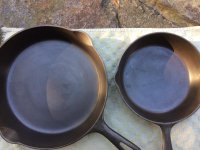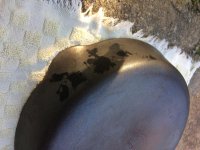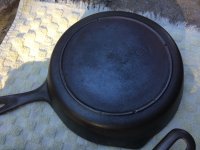Using baking soda, which is alkaline, seems counterintuitive to neutralize lye, also an alkali. More neutralization is occurring via just rinsing and diluting with plain water. Not to mention the lye won't hurt drain pipes, so you may get a little drain cleaning action. Just don't run the water hard so it splashes.That stuff can be quite caustic. It is a better practice to neutralize it so nobody down the line (garbage men, landfill workers) comes into contact with the lye. I have usually just changed out my refrigerator box of baking soda when I clean a batch of cast iron. I put the whole bag into the sink and sprinkle baking soda over the cast iron and rinse at the same time. This leaves just a wet plastic bag for the trash. Not a chemical burn hazard.
-
If a web search for the answer to your cast iron cookware question has brought you directly to this forum, the information you seek may be covered in one of the many reference topics featured on the main website.
Quick Links: · Main Website · How to Identify Unmarked Pans · All About Cleaning & Seasoning · Reproductions & Counterfeits · Commonly-Used Terms
You are using an out of date browser. It may not display this or other websites correctly.
You should upgrade or use an alternative browser.
You should upgrade or use an alternative browser.
Nitty gritty details about Easy Off HD method??
- Thread starter JamieC
- Start date
So here is how the skillets look after 2 sprays of Easy Off and around 10 days. I used my SS dish scrubby to scrub them and rinsed them thoroughly outside with the hose down our french drain.
Unfortunately the big skillet still has thick black gunk in two places on the outside, so it's going to have to go in for a third round, but I think the little skillet looks ready for the oven, right?
Also, I've been rinsing outside into the french drain like I said, and then spraying down the surrounding grass. I still have the trash bag full of paper towels and goo and rubber gloves. Should I dump a bunch of baking soda all over that and then rinse it with water before putting it in the trash then? Someone said not to stick the nasty bag of lye straight in the trash incase someone else got ahold of it.
Also, once the pans are thoroughly rinsed off inside, should I give them another rinse inside? Sprinkle with baking soda just to be sure? Or is a thorough water rinse good to go for the next step? Thanks so much for all the help!!!
Here is my first post with Before pictures in them, although I kind of think it's hard to compare the before and after shots. http://www.castironcollector.com/forum/showthread.php?t=4015
Unfortunately the big skillet still has thick black gunk in two places on the outside, so it's going to have to go in for a third round, but I think the little skillet looks ready for the oven, right?
Also, I've been rinsing outside into the french drain like I said, and then spraying down the surrounding grass. I still have the trash bag full of paper towels and goo and rubber gloves. Should I dump a bunch of baking soda all over that and then rinse it with water before putting it in the trash then? Someone said not to stick the nasty bag of lye straight in the trash incase someone else got ahold of it.
Also, once the pans are thoroughly rinsed off inside, should I give them another rinse inside? Sprinkle with baking soda just to be sure? Or is a thorough water rinse good to go for the next step? Thanks so much for all the help!!!
Here is my first post with Before pictures in them, although I kind of think it's hard to compare the before and after shots. http://www.castironcollector.com/forum/showthread.php?t=4015
Attachments
Last edited:
As noted above, baking soda is not a neutralizing solution here. Dilution with water remains your best option. Consider that when using it as actual oven cleaner, rinsing the sponge used to wipe internal oven surfaces with water in the kitchen sink would be a normal procedure. When you're ready to season them, washing with dish soap (preferably Dawn), rinsing, and drying well will be all that's necessary.
The remaining spots on the outside of the pan will probably not be affected by further treatment. Build up with no grease left in it has nothing for the lye to act upon. Your S/S scrubber is the best choice there.
The remaining spots on the outside of the pan will probably not be affected by further treatment. Build up with no grease left in it has nothing for the lye to act upon. Your S/S scrubber is the best choice there.
Oh right! Sorry I missed the baking soda part. Okay no baking soda. I will just continue to thoroughly hose off with water. So those black spots that are left look like something that won't be helped by a 3rd lye treatment? I've attacked them with the scrubby, but I guess I'll try again with the scrubby if you don't think I should do a third lye spray.
So I should just hose down all the garbage bag/paper towels/goo stuff then, to dilute the lye before putting in the trash?
Thanks!
---------- Post added at 05:15 PM ---------- Previous post was at 05:13 PM ----------
How do you know it's build up with no grease left? I take it you can tell from appearance?
So I should just hose down all the garbage bag/paper towels/goo stuff then, to dilute the lye before putting in the trash?
Thanks!
---------- Post added at 05:15 PM ---------- Previous post was at 05:13 PM ----------
The remaining spots on the outside of the pan will probably not be affected by further treatment. Build up with no grease left in it has nothing for the lye to act upon. Your S/S scrubber is the best choice there.
How do you know it's build up with no grease left? I take it you can tell from appearance?
W. Hilditch
Active member
The “crusty spots” are pure carbon which an e-tank won’t remove unless there is rust underneath them. Scrubbing the carbon off followed by vinegar is the best way to remove pure carbon.
Hilditch
Hilditch
If that were the case, electrolysis would not have cleaned the dozens of crusty pans I restored before I had a lye bath. There was no rust under the crud on them, not to mention it would be hard to imagine such a scenario occurring. Having said that, there are times that some of these remaining carbonaceous "warts" just don't seem to want to budge, no matter how long you leave them in the tank. Better to scrub them off and move forward.The “crusty spots” are pure carbon which an e-tank won’t remove unless there is rust underneath them. Scrubbing the carbon off followed by vinegar is the best way to remove pure carbon.
See the first photos of a crusty, not rusty, pan being cleaned with electro near the bottom of this page: http://www.castironcollector.com/electrolysis.php
W. Hilditch
Active member
I think I said pure carbon. Not carbon mixed with oxygen and other impurities.
Hilditch
Hilditch
I've had some success getting off some stubborn crud with electrolysis. I wasn't sure if it was the electrolysis which loosened the crud or the fact the pan was soaking in a water/washing soda solution for a few days ... but it seems to work. My best guess, from my limited-chemistry mind, was the electricity was breaking the bond between the carbon and the surface of the iron.
W. Hilditch
Active member
Spurgeon, we know positive electricity breaks the bonds of carbon on sacrificial graphite, steel and cast iron anodes; which is why they diminish in size one molecule at a time. On the negative side they break up impurities and oxygen bonds, but I’m not sure about actual carbon to iron bonds. That is why there is no ascertainable damage to cast iron after an extended time in an e-bath. So what you are experiencing may be the further disintegration of left over impurities and the soap doesn’t hurt. This is chemistry, not pseudoscience.
Hilditch
Hilditch
My theory, (and like I said my chemistry skills are limited) is that carbon is neutral and is attached to an iron pan which has a negative current running through it. Wouldn't that make the carbon be a negative and therefore be attracted to the positive charge of the "sacrificial steel"? I would call my high school chemistry teacher, but she recently passed away. Great teacher, but I missed half a semester with a bad case of mono. (That's my excuse anyway)
W. Hilditch
Active member
I don’t think so. However, I’ve only stayed at the Holiday Inn a few hundred nights.
Hilditch
Hilditch
I tried scrubbing them again with my scrubby and hot water and while I got a bit more off, it wasn't much. I don't have the ability to set up an E-tank, and I don't think I'm going to go through the lye process again. It would be nice to get it off, but since I really want to just start using these pans and I'm not a collector, I think I'm going to leave it on and enjoy the character spot, hoping that one day as it gets seasoned better the color difference will be less noticeable and I'll know that I'm making good progress. 



